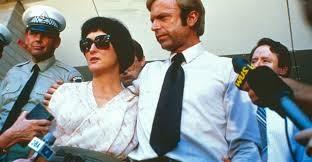 Fred Schepisi explores the intersection of crime and media in A Cry in the Dark (1988), aka Evil Angels. Despite inspiring endless jokes about dingo-eating babies, it's a solid mix of courtroom drama and social commentary.
Fred Schepisi explores the intersection of crime and media in A Cry in the Dark (1988), aka Evil Angels. Despite inspiring endless jokes about dingo-eating babies, it's a solid mix of courtroom drama and social commentary. A Cry in the Dark draws on an infamous true story. Lindy Chamberlain (Meryl Streep) and her husband Michael (Sam Neill), an Adventist pastor, take their children camping at Ayers Rock. Their youngest daughter, Baby Azaria is attacked by a wild dingo. Tabloid media obsesses over the story, ruining the Chamberlain's lives in more ways than once. An initial inquiry upholds the Chamberlain's version of events, but public outcry and scanty evidence lead to a second inquest. Soon Lindy's on trial for murder, experts scoffing at the story that a dingo would kill a child.
A Cry in the Dark doesn't question the Chamberlains' version of events. There's lingering doubt in some minds, though as recently as 2012 a new inquest reaffirmed their innocence. The early scenes play out as a mundane terror, the Chamberlains playing around Ayers Rock, hungry dingos munching handouts. When Lindy sees a dingo tearing into a tent she almost brushes it off... until she spots the empty bedspread. Unlike The Chant of Jimmie Blacksmith's bloody ax murders, Schepisi downplays the details. Lindy and Michael's horror, the campers' frantic efforts to locate their daughter, are horrifying enough.
Schepisi and writer Robert Caswell abandon the horror angle for a scabrous attack on Australian media. A Cry in the Dark suggests that Lindy's retrial and conviction resulted from character assassination. TV editors rejigger footage to make Lindy and Michael look horrible. Schepisi contrasts the trial with everyday Australians debating the case, police badmouthing a defensive judge, or more tellingly, a man changing the channel when he grows bored.
In this climate, Lindy and Michael prove their own worst enemies. As Seventh Day Adventists, their "cult-like" sect even inspires accusations of ritual sacrifice. Their flinty stoicism alone draws suspicion; Lindy's prickly reaction to press inquiries leads to conclude she's not mourning properly. Even during the trial, Lindy's sarcasm grates on judge and jurists alike. With the prosecution's evidence so shaky, public furor alone seems the driving force. The Chamberlains go from fairly ordinary Aussies to murderous outsiders, sacrificed to the public's appetite for scandal.
Meryl Streep underplays Lindy with resentment and bristling sarcasm. She doesn't try to make Lindy likeable; we sympathize with her loss and admire her defiance, yet Streep's Lindy remains sour and unpleasant. Sam Neill gets a more relatable character arc; Michael's near-stoic acceptance of Azaria's death devolves into torment, leading to a public breakdown.
If A Cry in the Dark isn't subtle, its central point is worth bearing out. American viewers will relate to the central story clearly enough: we've all survived JonBenets and Casey Anthonys in our lifetimes. Beneath juicy forensic details and judicial drama lies real tragedy: people die, lives upturned and families mourning. Meanwhile, ravenous reporters and an enraptured public will be there, watching every moment.

